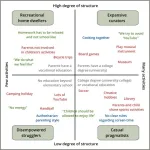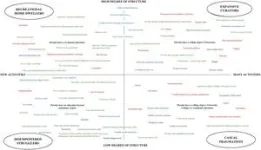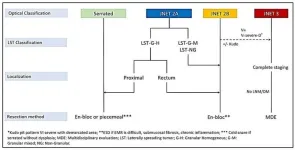(Press-News.org) Do children have regular bedtimes and do parents enforce strict screen time policies? And do parents take their children to museums so that they can learn from an early age? Or is everyday life more about having fun together, without clear rules and any ambition to ‘develop’ children in any particular way?
Family life can be lived in many different ways, and what children bring with them from the home environment has a substantial impact on their opportunities and development later in life.
A new study from the Department of Sociology, University of Copenhagen, and VIVE - The Danish Center for Social Science Research now offers a research-based typology of how the everyday lives of Danish families with young children can be grouped into four types of family learning environments. Four types that might influence children in very different ways.
"Learning environments are not just about playing spelling games with children," says Professor Mads Meier Jæger from the Department of Sociology, co-author of the study.
"Our study shows that there are big differences in the learning environments in which Danish children grow up, but also that it is possible to categorise them into different general types. Consequently, the study provides a comprehensive picture of children's learning environments and how individual dimensions of these environments interact," he says.
Level of activity, daily structure and learning environments
The study derives four types of family learning environments from rich data collected from 44 Danish families with children aged 3-6. Using a custom digital diary app, parents documented their family life with text, photos, audio and video over a period of 12 weeks. Parents were also interviewed.
From the data collected, the authors of the study outlined six dimensions particularly salient in characterising learning environments: Family activities, emotional climate, organisation of everyday life, social networks, expectations and values, and out-of-home care.
The six dimensions were then condensed into four typical learning environments on the basis of the level (and type) of family activities and the degree of structure in everyday life (see figure as well as brief description below). The diagram illustrates each learning environment by means of specific activities and statements.
According to Mads Meier Jæger, one of the strengths of the typology is that it is based on the activity level and everyday organisation of families. Previous research has confirmed that these are key dimensions in children's learning. In addition, the model shows a relationship between learning environments and parental education. This is consistent with research suggesting that education is the single strongest dimension of socioeconomic status.
The four categories should not be interpreted too rigidly. Many families may resemble more than one learning environment. Nor does the study say how many families belong to each of the four types. It is only the association between different activities, attitudes and underlying social factors that the researchers have mapped.
New Scandinavian perspective
Nevertheless, the categories provide a new, Scandinavian perspective on children's learning environments, as the study also includes children's school, institutional and leisure lives. The 'casual pragmatists' and 'recreational home dwellers' are very much products of the Scandinavian welfare regime and reflect other forms of inequality than those in economic and social typically of Anglo-Saxon countries.
"For example, children whose parents have vocational education and jobs are not socially disadvantaged. Parents have jobs and resources, but their focus is not on academic stimulation and children acquiring higher education. These families simply have other priorities," Mads Meier Jæger explains.
This way, the new typology provides a richer picture of how many individual parts of family life together create a family learning environment. This is important, Mads Meier Jæger says.
"In Denmark, we also have social inequality and lack of mobility in some dimensions. If we want to tackle these challenges, we need to understand where inequality originates. Our study tries to provide some answers by taking a more holistic approach.
The four learning environments in brief
(See also the attached simplified figure (Figure 1) and the study's original figure (Figure 2) with more examples)
Expansive curators tend to have a college/university degree and ensure that children have many educational and stimulating activities inside and outside the home (e.g. word games, music lessons and museum visits). The emotional climate is safe and everyday life is organised, for example with regular bedtimes and strict rules regarding children's use of screens. Parents are very active in their children's lives outside the home, which they see as an extension of their in-house learning environment.
Casual pragmatists tend to have a medium level of higher education, such as a bachelor's degree or perhaps a vocational education. As with the ‘expansive curators’, they also engage in many and varied activities, but typically with less focus on cognitive stimulation and under less supervision. Overall, daily life, while still emotionally stable, is more loosely structured in terms of meals, bedtimes, etc.
Recreational home dwellers tend to have a vocational education or similar. Like ‘expansive curators’, daily life is structured. However, family activities tend to take place in or near the home, and parents emphasise recreation rather than deliberately stimulating children. Spending time in the garden is preferred to visiting a museum, and watching Eurovision for kids is more common than playing the piano. The type of education children receive is less important if they receive one.
Disempowered strugglers have weakest social networks, few financial resources and sometimes no formal education. Families participate in few activities and family life is often characterised by uncertainty and lack of structure and, unlike the other three groups, the emotional climate can be unstable. Parents are rarely involved in their children's lives outside the home.
Facts about the study
The article 'Family learning environments in Scandinavia: dimensions, types and socioeconomic profiles' has been published in the British Journal of Sociology of Education.
The authors of the article are Mads Meier Jæger, Department of Sociology/UCPH, Katrine Syppli Kohl, Saxo Institute/UCPH, and Jens-Peter Thomsen, Sofie Henze-Pedersen, Kirstine Karmsteen and Rasmus Henriksen Klokker, all from VIVE - The Danish Center for Social Science Research.
The study is based on extensive analyses of qualitative data from 44 Danish families with children aged 3-6 years, including the families' electronic diaries, supplemented by a systematic literature review. The families were selected to cover a range of educational levels but are not representative of all Danish families.
The study is part of the project 'Learning environments in Danish families and their importance for children's development', which is supported by the A.P. Møller Foundation and primarily anchored at VIVE.
END
Family learning environments in Scandinavia: dimensions, types and socioeconomic profiles
Parental values and family activities have a strong influence on children's learning. Based on data from 44 Danish families, researchers have identified four types of family learning environments
2024-04-22
ELSE PRESS RELEASES FROM THIS DATE:
People think 'old age' starts later than it used to, study finds
2024-04-22
Middle-aged and older adults believe that old age begins later in life than their peers did decades ago, according to a study published by the American Psychological Association.
“Life expectancy has increased, which might contribute to a later perceived onset of old age. Also, some aspects of health have improved over time, so that people of a certain age who were regarded as old in the past may no longer be considered old nowadays,” said study author Markus Wettstein, PhD, of Humboldt University in Berlin, Germany.
However, the study, which was published in the journal Psychology and Aging, also found evidence that the trend of later perceived old age has slowed ...
Afib more common and dangerous in younger people than previously thought
2024-04-22
PITTSBURGH, April 22, 2024 – Atrial fibrillation (Afib), a common type of arrhythmia that is on the rise in people under the age of 65, is more dangerous in this increasingly younger population than previously thought, according to a new study published today in Circulation Arrhythmia and Electrophysiology and authored by physician-scientists at the UPMC Heart and Vascular Institute.
The study, which is among the first to examine a large group of Afib patients younger than 65 in the U.S., found that these younger patients were more likely to be hospitalized for heart failure, stroke or heart ...
To accelerate biosphere science, reconnect three scientific cultures
2024-04-22
Researchers who study Earth’s biosphere tend to operate from one of three scientific cultures, each with distinct ways of conducting science, and which have been operating mostly independently from one another, find the authors of a Perspective published in PNAS on April 19, 2024. SFI Professors Christopher Kempes and Geoffrey West, together with External Professor Brian Enquist (University of Arizona) identify and explain the three cultures, and suggest that reconnecting them could help accelerate ...
Endoscopic techniques for removing large colorectal polyps
2024-04-22
Colorectal cancer (CRC) is the second most common cancer in the United States. This highlights the importance of early detection and treatment of precancerous lesions like large polyps. Endoscopy offers a minimally invasive approach to removing these polyps, reducing the need for traditional surgery.
This review, published in eGastroenterology, explores advancements in endoscopic resection techniques, specifically Endoscopic Mucosal Resection (EMR) and Endoscopic Submucosal Dissection (ESD).
Complete removal of large polyps (>10 mm) is crucial to prevent progression to CRC. Piecemeal resection during endoscopic procedures can increase the risk ...
Speech Accessibility Project now sharing recordings, data
2024-04-22
The Speech Accessibility Project, which aims to make automatic speech recognition technology more accessible to people with speech differences and disabilities, is now sharing some of its voice recordings and related data with universities, nonprofits and companies.
The project team is accepting signed data use agreements and one-page proposals for 211 recordings of people with Parkinson’s. The download also includes text of the original speech prompts and a transcript of the participants’ responses. A subset includes annotations ...
Scientists in Missouri, Virginia receive pediatric heart transplantation research grants
2024-04-22
DALLAS, April 22, 2024 — Scientific researchers in Missouri and Virginia have been awarded nearly $1.4 million each in grants to study ways to extend the life expectancy and improve the quality of life for children with a transplanted heart. These two research awards mark the latest round of funding for a joint $3 million scientific research initiative between the American Heart Association, celebrating 100 years of lifesaving service as the world’s leading nonprofit organization focused on heart and brain health for all, and Enduring Hearts, the only non-profit organization solely dedicated ...
Same species, different sizes: rare evolution in action spotted in island bats
2024-04-22
A University of Melbourne researcher has spotted a rare evolutionary phenomenon happening rapidly in real time in bats living in the Solomon Islands.
Dr Tyrone Lavery reports in a paper published in Evolution that two groups of leaf-nosed bats with vastly different body sizes that were thought to be separate species are an example of a rare type of parallel evolution. Parallel evolution is when different populations living in similar environments evolve similar features independently.
The smaller bat, Hipposideros diadema, is found across its six main islands and many smaller islands. It is ...
New technology uncovers mechanism affecting generation of new COVID variants
2024-04-22
The SARS-CoV-2 virus that causes COVID has the unsettling ability of often generating variants of itself. Other viruses also mutate, but as SARS-CoV-2 quickly spread throughout the entire human population during the pandemic, killing millions, the virus’ dynamic evolution posed a serious problem: it repeatedly challenged our bodies’ immune response fighting the virus and hindered the process of getting updated vaccines ready.
Understanding the genetic mechanism fueling SARS-CoV-2’s ability to generate variants can go a long way in keeping COVID at bay. In this study published in Nature Microbiology, researchers at Baylor College of Medicine and collaborating institutions developed ...
Planning at multiple scales for healthy corals and communities
2024-04-22
Governments in the Mesoamerican Reef region are exploring the use of nature-based solutions to strengthen coral health and societal benefits for coastal communities. A new study led by Stanford researchers in collaboration with scientists from the World Wildlife Fund, the Healthy Reefs Initiative, and others from the Smart Coasts project quantified the outcomes of different watershed interventions to support coral health at regional versus national scales, and identified target areas that could improve both ecosystem and societal benefits nationally and across the region.
The nature-based approaches evaluated as key ...
U of T researchers map protein network dynamics during cell division
2024-04-22
An international team led by researchers at the University of Toronto has mapped the movement of proteins encoded by the yeast genome throughout its cell cycle. This is the first time that all the proteins of an organism have been tracked across the cell cycle, which required a combination of deep learning and high-throughput microscopy.
The team applied two convolutional neural networks, or algorithms, called DeepLoc and CycleNet, to analyze images of millions of live yeast cells. The result was a comprehensive map identifying where proteins are located and how they move and change in abundance ...
LAST 30 PRESS RELEASES:
Myeloma: How AI is redrawing the map of cancer care
Manhattan E. Charurat, Ph.D., MHS invested as the Homer and Martha Gudelsky Distinguished Professor in Medicine at the University of Maryland School of Medicine
Insilico Medicine’s Pharma.AI Q4 Winter Launch Recap: Revolutionizing drug discovery with cutting-edge AI innovations, accelerating the path to pharmaceutical superintelligence
Nanoplastics have diet-dependent impacts on digestive system health
Brain neuron death occurs throughout life and increases with age, a natural human protein drug may halt neuron death in Alzheimer’s disease
SPIE and CLP announce the recipients of the 2025 Advanced Photonics Young Innovator Award
Lessons from the Caldor Fire’s Christmas Valley ‘Miracle’
Ant societies rose by trading individual protection for collective power
Research reveals how ancient viral DNA shapes early embryonic development
A molecular gatekeeper that controls protein synthesis
New ‘cloaking device’ concept to shield sensitive tech from magnetic fields
Researchers show impact of mountain building and climate change on alpine biodiversity
Study models the transition from Neanderthals to modern humans in Europe
University of Phoenix College of Doctoral Studies releases white paper on AI-driven skilling to reduce burnout and restore worker autonomy
AIs fail at the game of visual “telephone”
The levers for a sustainable food system
Potential changes in US homelessness by ending federal support for housing first programs
Vulnerability of large language models to prompt injection when providing medical advice
Researchers develop new system for high-energy-density, long-life, multi-electron transfer bromine-based flow batteries
Ending federal support for housing first programs could increase U.S. homelessness by 5% in one year, new JAMA study finds
New research uncovers molecular ‘safety switch’ shielding cancers from immune attack
Bacteria resisting viral infection can still sink carbon to ocean floor
Younger biological age may increase depression risk in older women during COVID-19
Bharat Innovates 2026 National Basecamp Showcases India’s Most Promising Deep-Tech Ventures
Here’s what determines whether your income level rises or falls
SCIE indexation achievement: Celebrate with Space: Science & Technology
Children’s Hospital Colorado performs region’s first pediatric heart and liver dual organ transplant
Australian team discover why quantum computers have memory problems over time
What determines the fate of a T cell?
Candida auris: genetic process revealed which could be treatment target for deadly fungal disease
[Press-News.org] Family learning environments in Scandinavia: dimensions, types and socioeconomic profilesParental values and family activities have a strong influence on children's learning. Based on data from 44 Danish families, researchers have identified four types of family learning environments




